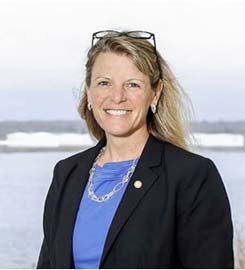You can’t order someone to come up with a particular creative idea. That’s not how it works.
No editor ever said to Herman Melville, “Hey, Herm! How about you write a long, long novel about an obsessed whaling captain pursuing a great white whale? Feel free to intersperse the narrative with chapters detailing the grisly art of whale slaughter and processing. Be sure to have the whale kill the captain in the final pages. And give the whale a memorable name, like ‘Moby-Dick.’ Got it?”
No, creative people develop their ideas themselves, informed by their own set of experiences, education, needs, interests, ingenuity, vision, and interactions with other inventive folks – and if their ideas are good, and if there’s support, they gain traction.
That’s the way venture capital works. Entrepreneurs pitch venture capitalists with ideas that, if successful, turn into companies like PayPal, Uber, and Twitter. That is to say, venture capitalists don’t come up with the ideas; instead, they recognize a good idea when they see it.
In the old days, that also pretty much described how foundations did their grantmaking. Each foundation would articulate a broad area of interest – healthcare, or the arts, or children and families, or education, or some combination – and the foundation leaders would invite nonprofits in those fields to submit proposals. If the ideas seemed like a good return on the foundations’ investment, and if the leaders of the projects seemed capable and trustworthy, the foundation would make a grant to help them along.
That was then. Now, it’s different.
More and more foundations don’t even accept unsolicited applications, or they designate only a small portion of their grant dollars to these kinds of over-the-transom proposals. Instead, these foundations focus on “strategic grantmaking.” Nobody’s against the notion of being strategic. But “strategic grantmaking” is foundation-speak for the foundation itself developing programs, priorities, and strategies. The foundation then essentially hires nonprofits (not literally, but by providing them with grants) to carry out the foundation’s plans.
In many ways, this approach by foundations is an efficient use of their grant dollars. I get that: the money goes out in a more focused way. The grantmaking is less scattershot.
But I have two major problems with this trend. The first is that a nonprofit, by definition, has to be known in order to be brought in as “a strategic partner/grantee.” So the funds flow toward known, established entities – and certainly not to new nonprofits and smaller entities. Consequently, it tends to be a who-you-know kind of process, with the older, more-established organizations dominating.
Of even greater concern to me: When foundations don’t accept unsolicited applications, they shut out creative ideas that rise up out of the community.
Some of those ideas may seem like longshots. But some of the craziest ideas turn out to be winners.

For example, a little more than a decade ago, Michelle Ollie and James Sturm, two cartoonists marooned in Northern Vermont, hatched an improbable scheme: to create a graduate school (offering a Master of Fine Arts degree) specifically for aspiring cartoonists, based in the dusty old railroad town of White River Junction, Vermont. In an era where colleges are closing, not opening, and where the creative arts thrive in urban areas, not in small rural towns that define “seen better days,” it would be reasonable to have expected that this little enterprise would fail before it began.

But Michelle and James brought passion, smarts, connections, and (by definition) creativity to their enterprise. Now they have a thriving institution of higher education, the Center for Cartoon Studies, based in the former White River Junction Post Office, and borrowing other space in once-vacant buildings around town. The Center is operating at capacity, has a growing list of successful alumni, annually balances its budget, and has built a strong reputation in its field. The Center has also played a role in transforming White River Junction into a funky and lively arts center. (Some people refer to the town, only partially tongue-in-cheek, as the Brooklyn of Vermont.)

The Center for Cartoon Studies could only have happened because of the drive, genius, and belief of their founders. So too with so many other nonprofits I know. I think of Boots2Roots, a small volunteer organization founded by a retired Air Force colonel, Dave Hickey, and built from the ground up by retired Air Force colonel Jen Fullmer. Dave and Jen identified a gap in services for transitioning active duty military members in Maine. Boots2Roots has helped dozens of Maine’s newest veterans hit the ground running, gain and maintain financial stability, and start contributing to the state’s businesses and communities. Or the Children’s Literacy Foundation (CLiF), founded 21 years ago by Duncan McDougall, then a management consultant working in Boston and trying to make meaning of his life. Duncan started a remarkable enterprise that for more than two decades has provided free and inspiring literacy programs and brand-new books to 250,000 low-income, at-risk, and rural children in communities throughout New Hampshire and Vermont.
No foundation could possibly have come up with the one-off concepts that inspired the Center for Cartoon Studies, Boots2Roots, or CLiF. Even if they had, the foundations certainly couldn’t have found anyone to run them successfully. Top-down dictates don’t work in the charitable world any better than they would in the venture capital/start-up world.
Foundations tend to emulate one another, and the current trend, I fear, is for foundations to underappreciate ideas that rise up spontaneously from below. Instead, foundations seem determined to spread wisdom and dollars in tandem from above. These foundation leaders mean well. They take their roles seriously. They are focusing on being efficient and effective and maximizing the impact of their limited resources. I do not in the slightest impugn the integrity or intent of those behind the strategies I criticize.
But in trying to use every dollar wisely, foundation leaders miss a key point: that genius for the most part lies not within the foundation world, but out in the community. Foundations need to find and nurture those leaders willing to take their daring ideas, bring them to fruition, and translate them into institutions that create impact. Foundations should provide seed capital and ongoing support. And the foundations should then do their very best, despite their inherent power vis-à-vis the grantees, to keep quiet and stay out of the way.
I would love to open a dialogue on this subject. The comments section is here for a reason. Please have at it: I invite your reactions, including and especially thoughts that disagree with mine.
Copyright Alan Cantor 2019. All rights reserved.
[Full Disclosure Department: The Center for Cartoon Studies has been a client of mine, and my wife Pat is on the Advisory Board of the Children’s Literacy Foundation.]


14 Comments. Leave new
Talk with Vu Le about this. He’s there with you and has lots of ideas for change needed.
I love being on the same side of an issue as Vu! More often than not, we are!
The whale kills the captain in the end? Thanks for the spoiler, Al.
Happy to save you some time, Michele…
No disagreement here! In an ever growing climate of nonprofits having to struggle for funding, especially smaller nonprofits, this is critically important. Community development, as you stated, happens in the community. It would serve Foundations well to develop strategies particularly focused on incubating those new ideas. Listening is a good start!
In my experience, so many of the local foundations are risk adverse or have changed their focus to such targeted issues and needs that the entrepreneurial start-up programs that are responding to a community need don’t “fit.” On top of that, very few still understand the need for capacity-building and operational support above all other things… (still.)
Thanks, Carol. Yes to all you say.
I of course am painting with a very broad brush here. I do see this as a trend — and statistics show that the number of foundations not accepting unsolicited proposals has grown steadily in recent years. Fortunately, there are a few examples of foundations investing in capacity-building and operational support, such as a commitment recently by the New Hampshire Charitable Foundation to multi-year operational support for lots of nonprofits in the state.
Spot on post! In my previous role, we were researching grants to support the start-up phase for a new service that would be revenue generating in three years which would help cover the costs for non-service revenue programs and it was hard to find places which were open to receiving a proposal. When you think about the purpose of a foundation grant, one would think providing funds to make an organization more self-sustaining would be an ideal ask of a funder – but it was challenging to find folks who were open to receiving our pitch.
Thanks, Gene!
I should add that 22 years ago, I was working at a northern New England foundation when Duncan McDougall approached me with the idea for the Children’s Literacy Foundation. I thought he was earnest and idealistic, and I put the chance for his success at about 2%. (Shows what I know!)
Nice article Alan. I wouldn’t put venture capitalists generally in the same category as the Medici’s. Part of the issue too is the growth trend in new charities over the last decade, change in tax law and the proliferation of donor advised funds even amongst community foundations.
Thanks, John. As a couple of friends have said to me today by email, they find my sudden affection for venture capitalists… peculiar.
I guess my reference can and should be taken with a grain of salt — my thoughts were far more about foundations than about VCs. And, yes, all these other issues you mention are huge. We’re still waiting to feel the full fall-out from the change in the tax law (see my essay from when it passed in 2017), and I’ve written so much about donor-advised funds that I thought people would enjoy the break this week! 🙂 Thanks again!
How do you reverse this trend when more and more money is being directed from DAFs to established charities? How do you incentivize THOSE “foundation” dollars going to community leaders with big vision…but few connections?
Hi, Adam — Thanks for your thoughts, and I hope you’re well.
In this post I am only focusing on a very narrow slice of the philanthropic pie: the piece that’s actually coming from foundations with program staff and a review process. The amount in all coming from foundations is I think 16% — and a lot of that, as you indicate, is from donor-advised funds, or private foundations that are essentially done from the kitchen table or family office.
I think the donor-advised fund money should really be considered one and the same as money from individuals — if, often and sometimes annoyingly, through an intermediary. A large issue, as described in the Institute for Policy Studies “Gilded Giving 2018” report, is that wealthy folks give to different causes than middle-class people — and, of course, at much higher levels. The big recipients from the rich are healthcare and education, which is why Harvard managed to bring in $3 billion more than it set out to raise in its most recent campaign.
So many issues, many of them tied to the growing wealth disparity. Again, this is just a slice. Thanks.